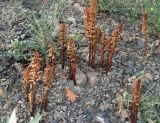
Отцветшие растения (паразитируют на Lactuca viminea). Крым, Ялта, Грузпорт, каменистая осыпь. 27 мая 2014 г.
The marker on the map does not indicate the exact coordinates of the plant or lichen.
The marker does only indicate the conditional center of the terrain ("geographic point") where the photo was taken.
Open mapSee also:
Discussion (1)
All photos of taxon (34)
Code of link to photo
| Create: | HTML or BBCode with preview |
| Code for linking on the web: | |
| This is how it will look: |  Orobanche grenieri on the site «Plantarium» |
Text to cite the page
Фатерыга А. 2014. Изображение Orobanche grenieri F.W. Schultz // Плантариум. Растения и лишайники России и сопредельных стран: открытый онлайн атлас и определитель растений. [Электронный ресурс] URL: https://www.plantarium.ru/page/image/id/240324.html (дата обращения: 25.12.2025).
Fateryga A. 2014. Image of Orobanche grenieri F.W. Schultz // Plantarium. Plants and lichens of Russia and neighboring countries: open online galleries and plant identification guide. URL: https://www.plantarium.ru/lang/en/page/image/id/240324.html (accessed on 25 Dec 2025).
Views: 2079Discussion
| Alexander Fateryga | Raab-Straube E. von & Raus Th. (ed.): Euro Med-Checklist Notulae, 5 [Notulae ad floram euro-mediterraneam pertinentes 34]. — Willdenowia 45: 449–464. 2015:
Orobanche grenieri F. W. Schultz — Fig. 2. + Ab(A): Azerbaijan: Talysh, NE side (near the border to Iran), near Şonaçola (S of Lerik), 38°41′01.3″N, 48°22′45.5″E (WGS 84), c. 1410 m, Artemisiasteppe on little hills, S of the small stream Konjavuçay, in open and sunny place, in loose siliceous grit, parasitic on perennial Lactuca species (root attachment verified), 27 May 2013, Rätzel, Ristow & al. (herb. Rätzel). — Orobanche grenieri has for a long time been interpreted as a synonym of O. cernua Loefl., until Carlón & al. (2005: 29) showed its discreteness. For this taxon, so far known only with certainty from France and Spain, Piwowarczyk & al. (2015: 411) gave first locations for Asia (Georgia and Tajikistan). They mentioned further doubtful records from N Italy and the Black Sea region, which have been confirmed by Carlón & al. (2005+) and which we can confirm here as well, according to the following images and specimen: Italy, Liguria, Prov. Savona, Toirano, 44°7′31.8″N, 08°12′28.5″E, Apr 2008, Renzo Salvo (photo, as “O. minor Sm.”, at http://www.actaplantarum.org/floraitaliae/viewtopic.php?t=8525); Turkey, Yozgat Prov., 10 km E of Yerköy, 39°38′17″N, 34°28′02″E, direction to Karacaahmetli, on Lactuca viminea, 19 May 2004, Coulot PC-8 (herb. Coulot); Crimea, Feodosia, Karadagskiy Prirodny Zapovednik, 44°56′10″N, 35°14′00″E, dry coastal slope, on Lactuca viminea, 10 May 2013, Fateryga (photo, as “O. cernua Loefl.”, at http://www.plantarium.ru/page/image/id/185943.html); ibid., Yalta, Gruzport, 44°30′05″N, 34°12′07″E, scree, on Lactuca viminea, 27 May 2014, Fateryga (photo, as “O. cumana Wallr.”, at http://www.plantarium.ru/page/image/id/240324.html). The two localities for N Turkey mentioned in Carlón & al. (2005+; see also map in Piwowarczyk & al. 2015: 412, fig. 1) are in fact identical; they both rely on the same specimen collected by P. Coulot. The finding from Azerbaijan adds to the Transcaucasian part of the distribution. The circumstances at this location confirm the classification of this taxon as a species: the plants of this population were growing exclusively on Lactuca, but never on any of the surrounding abundant Artemisia plants (the main host of Orobanche cernua s.str.). Orobanche cernua, additionally differing in colour, was missing. It was found in different other locations in Azerbaijan, always growing on Artemisia. S. Rätzel, M. Ristow & H. Uhlich |